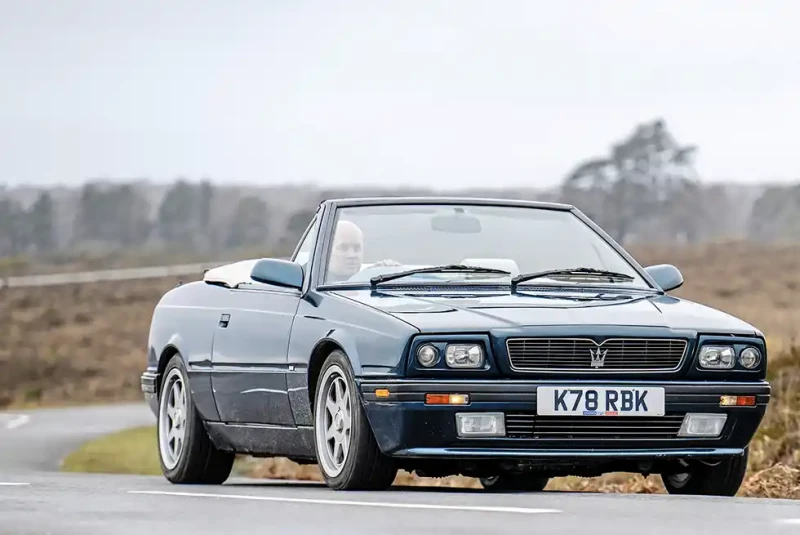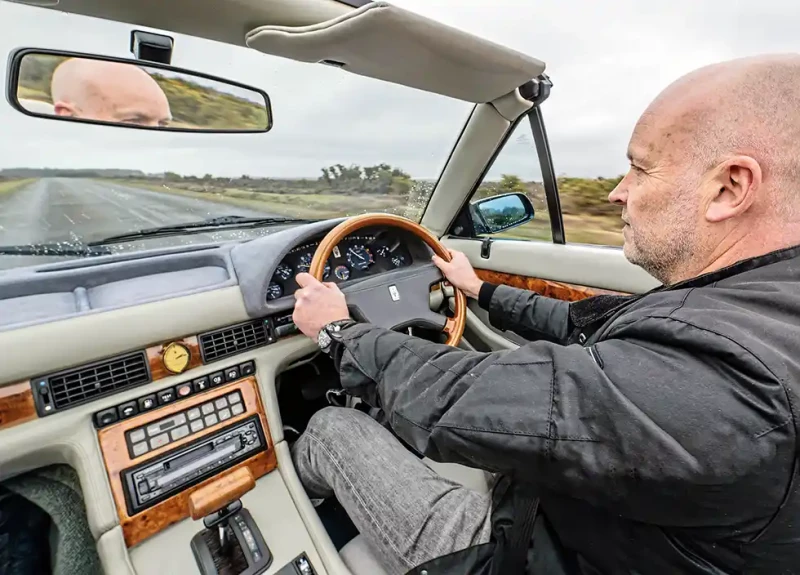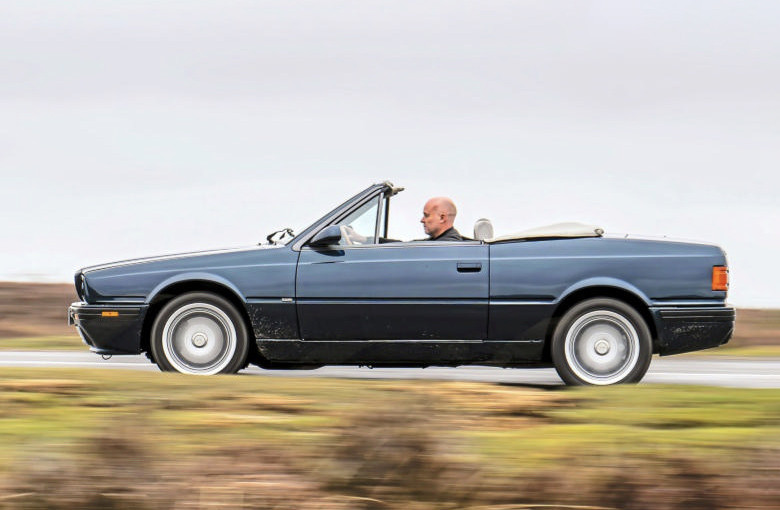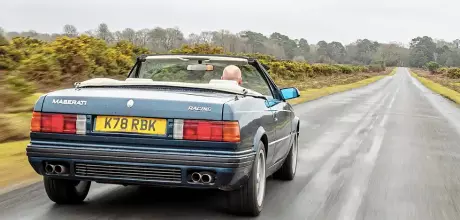1992 Maserati Spyder III
We put designer Adrian Morris in the object of his curiosities, a Maserati Biturbo – but will it leave him feeling boosted or busted?
Words NATHAN CHADWICK
Photography IAN SKELTON
‘It’s just such a glamorous thing’
Reader tries dream Maserati Biturbo – result?
CC reader and designer Adrian Morris assesses Maserati’s infamous BiTurbo

The List We put a CC-reading design guru in Maserati’s controversial BiTurbo Spyder
Bravery. Most people would view the whole Maserati endeavour, let alone the Biturbo cars, as the dictionary definition of the word. From reliability to running costs, there are a multitude of miseries that, according to the internet, await the unwary. Even our reader, designer Adrian Morris, believes choosing a Biturbo over a contemporary BMW would have taken some guts back in the day.
Further bravery is required today because we’re putting Adrian in a Biturbo Spyder, a short-wheelbase version of the model designed and initially built by Zagato, in the rain. Could the Biturbo’s reputation for spiky wet-weather handling dampen Adrian’s enthusiasm? He shows no concern as he pulls into the grounds of the National Motor Museum, Beaulieu, to take in Ewan Clark’s 1992 example. However, will his bravery persist behind the wheel?
‘I think the fascination with Maserati comes from the name as much as anything,’ Adrian explains as we size the car up. ‘Growing up in the Seventies, it just seemed like such a glamorous, unusual brand in Britain.’

Of course, public perception of Maserati style differs depending upon who you talk to, and what their reference point in the firm’s 120-year rollercoaster history might be. While regular readers may know that I’m a fan of the Trident’s angular phase, for many the Biturbo is seen as Maserati’s aesthetic nadir. That’s not the case for Adrian, and he knows a bit about design – he’s the chap who has styled award-winning automotive books by Steve Saxty. ‘I’m slightly fascinated by saloon-style coupés rather than straight sports cars, like the E30 BMW 3 Series,’ he explains; he’s owned an E30 cabriolet and an earlier Baur 3 Series convertible. ‘I suppose the Eighties Maseratis were a bit like that – I know they’re sports cars, but they look like a saloon to a normal person. I’m fascinated by the whole concept of it, how Maserati went from making traditional sports cars in the Sixties and Seventies to adopting a boxy design language.’
Adrian’s fascination with the Biturbo was first spurred through a chance encounter while driving through Heathrow Airport’s tunnel many years ago. ‘I remember thinking, that’s just such a glamorous thing,’ Adrian recalls. ‘I suppose I like trying to put myself into the position of someone in 1992 who was quite wealthy, liked Italian cars, and wanted something more sporting and exclusive than a BMW – because no-one else would have one. It’s someone who is very single-minded – I like that about human beings, where they’re like, nope, that’s the one I want.’ As Adrian takes in the car’s shape, his designer’s gaze deepens. ‘I love that it’s so squat, so small – and the Zagato badge,’ he smiles, moving to the Spyder’s snout. ‘I like the sharknose BMW effect at the front, and the fact it hasn’t got more of a chromed grille like the earlier cars. I think the facelift is successful, with new lighting and body-coloured bumpers. It’s typically Italian though – why are the fog lights bigger than all the other lights? ‘I like the proportions of it – Zagato didn’t have to make it a shorter wheelbase, it was obviously a difficult thing to do and it’s made it a much more sporty-looking car,’ Adrian says. ‘What else could you get that looks like this, I can’t think of another car – an E30 3 Series is a lot longer and has four seats.’

Time for Adrian to step inside, and it’s clear this is where the fascination with the Biturbo deepens. Even though late-model Biturbos lacked the outright flair of the early Missoni-appointed cabins, this example’s interior certainly strikes a chord with Adrian – and one bit in particular. ‘I’ve always been slightly obsessed by the oval clock,’ he laughs, which deepens when hediscovers that rather than delete the map light button from the saloon, Maserati repurposed it to solely light the LaSalle clock. ‘It’s the quality of the materials that jumps out at you most,’ says Adrian of the interior, more generally. ‘The suede, leather and the wood on the wheel really speaks of Italian quality, doesn’t it. All of this veneer and everything else is so well-preserved – it hasn’t cracked or come away. I even like the carpet, it’s almost herringbone. It’s as if they’ve employed really, really high-end interior designers and makers and said: no, you’re going to make cars now.’
Adrian’s a big fan of Italianate exoticism. ‘It comes from being taken to school in a Lancia Fulvia belonging to a friend’s parents,’ he says. ‘Words like Olio and Benzina on the instruments, they just seem so different. In the Biturbo, I love the Turbo boost gauge – I think it’s key that it’s right there in front of the wheel, because that’s why you would have bought the car.’
It may look and feel nice, but what of that oft-repeated complaint about Biturbos and Italian cars in general – somewhat haphazard ergonomics? Adrian seems to have settled in fine. ‘I’ve never really struggled with Italian short legs/long arms pose. Overall it feels a bit more special than a BMW, it doesn’t feel mass-produced, it feels handbuilt. These seats look like something out of 2001: A Space Odyssey; they’re very cool.’ There’s a similar love of the aesthetics under the bonnet. Adrian freely admits to being less knowledgeable about the mechanics of a car compared to its aesthetics and performance, but is suitably enamoured with the 90. twin-turbocharged V6, ‘I’m fascinated by the feeling of Eighties/Nineties turbocharger coming on boost. It’s just an entirely different kind of experience from most turbos these days,’ he enthuses.

On that note, with the wind and rain easing it’s time for Adrian to make his dream drive real. ‘I love the sound of the engine – even at tickover it sounds inviting. It makes you want to go faster – and the note with the roof down is particularly nice.’
Despite a reputation for waywardness, the Biturbo experience is proving to be encouraging rather than frightening. ‘It’s a lot more practical than I imagined it could be – you could use it all the time. I wouldn’t put the dog in it because it would ruin the interior, but the children? Possibly I’d let them in, I’m not sure,’ Adrian smiles. ‘The engine’s not spiky at all, it’s very smooth. I think the ride comfort is perfect – not too hard, not too soft, and certainly not too wallowy through the corners and quite planted, seeing as the wheels and tyres aren’t that big. They obviously spent a lot of time on the suspension and setup – I feel confident. ‘It’s rewarding too; in the twisty bits it really flows. You turn the wheel and you feel everything about what it’s doing, it’s not disconnected from your inputs – I really like that about it. The steering is definitely better than my E30, it feels a lot more pointy. For some of the E30s, the steering isn’t their greatest attribute. The ride comfort is about the same.’
Though Adrian doesn’t get to test out the car’s ultimate braking ability, he finds himself comfortable with the Biturbo. ‘I suppose if you’re being an idiot, driving it for the first time at high speed, it might catch you out, but the way I’m driving it, it feels very comfortable.’ That comfort continues with the four-speed automatic gearbox, which by modern standards is fairly agricultural; Adrian, who hasn’t driven an auto for a long while, doesn’t seem fazed. ‘The way it shifts is not something I notice too much, which is probably the best thing going for it, isn’t it?’ he says. ‘At really low speeds I felt I didn’t know what it was doing, but now we’re moving it’s really smooth.’
So far so good, but as the clouds darken and the return of the rain threatens to sully the Maserati’s interior, time to head back to the National Motor Museum for a chat and debrief. ‘I have a history of buying cars on photoshoots – it’s not something that I’m ever allowed to repeat,’ Adrian admits, referring to the Baur Convertible he used to own. ‘Let’s just say that there were some raised eyebrows when I arrived back home that day.’

Nevertheless, Adrian is impressed with the Maserati. ‘At the beginning I was thinking, if someone had that kind of money to spend, why didn’t they just get an E30 M3 or whatever else was available at the time, but I can actually see why they didn’t,’ he says. ‘It feels individual, whereas you can drive six examples of the same BMW model and they all feel the same.’
He’s also a big fan of the Biturbo’s subtlety, especially compared to the conceptually similar Ferrari Mondial droptop. ‘I wouldn’t want the attention that a Ferrari brings; I know that you can get them in dark colours, but I’d be a bit self conscious. In the Maserati I know that 50 per cent of people wouldn’t give me a second look, and I like that. But the people who know it would be impressed, or think “that’s brave”. Some people can pull off driving a red Ferrari – I’m not one of them.’
Having driven the Biturbo, he’s now got a greater understanding of its appeal. ‘The car’s suited to someone that likes handbuilt things, whether it's watches or bags – some people just like that exclusivity, and they’re prepared to pay for that. There aren’t many ways you can get that for £20k – start talking about Zagato-built Astons and you’re in a whole different world. The fact this car has a Zagato badge makes it very special.’ So, would Adrian put risk putting domestic harmony at risk with another post-photoshoot purchase? ‘I never would have considered a Spyder before, but maybe it’s the more special choice – I live on the coast and when we have some nice days it would be perfect as a boulevard cruiser.’
But what of the car’s infamously ruinous reputation? Well, after spending time with the owner and I discussing the realities of Biturbo-era Maserati ownership, Adrian doesn’t feel apprehensive. ‘It seems a lot of car for the money. For someone like me who didn’t know anything about Biturbos, I’d never consider it apart from in my dreams, but now I’ve met a few people that know a bit about them, I feel a lot more reassured.’ Something tells me Adrian’s going to be keeping the classified section of Classic Cars well thumbed, just in time for summer. ‘It’s something that’s piqued my interest for a long time – and it surpassed my expectations.’
Thanks to Ewan Clark for the loan of the car, and the National Motor Museum, Beaulieu, for the use of the café.
Former BMW E30 owner Adrian could see himself owning this leftfield rival.
‘It’s almost as if they’ve employed really, really high end interior designers and makers and said: no, you’re going to make cars now’ Adrian and Nathan discuss engine packaging Spyder didn’t receive full-fat dohc biturbo.
TECHNICAL DATA 1992 Maserati Spyder III
- Engine 2790cc V6, sohc, Weber Marelli electronic fuel injection, two IHI turbochargers
- Max Power 224bhp @ 5500rpm
- Max Torque 268lb ft @ 3500rpm
- Transmission Rear-wheel drive, four-speed automatic gearbox
- Steering Power-assisted rack and pinion
- Suspension Front: MacPherson strut, anti-roll bar, coil springs, telescopic dampers. Rear: semi-trailing arms, coil springs, telescopic dampers, anti-roll bar
- Brakes Servo-assisted discs all round, vented at front
- Performance Top speed: 143mph
- Acceleration 0-60mph: 6.1sec
- Weight 1345kg (2965lb)
- Fuel consumption 25mpg
- Cost new £36,895
- Classic Cars Price Guide £4000-£13,250
Adrian loves the clock that others poke fun at. Two turbos, one gauge, lots of urge Interior aces the Eighties checklist.


